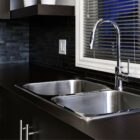DIY home renovation has become increasingly popular in recent years. Whether you’re looking to update a single room or undertake a major renovation project, having the right tools is essential to achieving your goals.
From power tools to hand tools and everything in between, we’ll show you how to choose the right one for the job and how to use them safely and efficiently.
So if you’re ready to take on your next project, read on!

- Power tools
- Hand tools
- Measuring and leveling tools
- Safety gear
- Painting tools
- Plumbing tools
- Electrical tools
- Flooring tools
- Wall repair tools
How to use home renovation tools safely
- Always read the manual that comes with the power tool. This will give you an understanding of the tool’s features, how it operates, and any safety precautions that need to be taken.
- Check the tool for any damage that could affect its performance or safety. Make sure all the guards, switches, and cords are in good working order.
- Wear appropriate safety gear like goggles, earplugs, gloves, and dust masks to protect yourself from debris and noise.
- Clear the work area of any obstacles, debris, or tripping hazards. Ensure that there is enough space to move around freely.
- Plan the work you need to do, and make sure you know how to use the tool properly. Be aware of any potential hazards, and take steps to mitigate them.
- Make sure the tool is connected to a properly grounded electrical outlet or that the battery is fully charged before using it.
What to consider when choosing tools for DIY home renovation
Here are some factors to consider when selecting tools for your project:
- Type of project: Consider the type of project you are undertaking. Choose tools that are suitable for a specific job.
- Budget: Determine how much you are willing to spend on tools. Does it make sense to pay for tools that you’ll only use once?
- Quality: Invest in high-quality tools that are built to last. Although they may cost more, they will save you money in the long run.
- Safety features: Choose tools that have safety features such as guards, safety switches, and safety goggles to prevent accidents. Nothing is more precious than your health.
- Ergonomics: Consider the weight, balance, and grip of the tool. Choose tools that are comfortable to hold and use.
- Compatibility: Ensure that the tools you choose are compatible with the materials you will be working with.
- Brand reputation: Choose tools from reputable brands that have a history of producing quality products. Read reviews and ask for recommendations from friends and family.
- Skill level: Consider your skill level when selecting tools.
Renovating Old Homes is not about making them look new. It is about making new unnecessary
TY MC BRIDE
Essential power tools
What power tools will you most likely be needing?
- Power drill/driver: This tool is used to drill holes and drive screws into walls, wood, and other materials. It’s an essential tool for almost any home renovation project, from installing shelves to building furniture. Cordless drills are more convenient for DIYers because they’re easy to handle and can be used in tight spaces. An alternative to a power drill is a hand-held manual drill.
- Circular saw: A circular saw is used to cut large pieces of wood, sheet metal, or plastic. It’s ideal for cutting straight lines and making precise cuts. Alternatives to a circular saw include a handsaw or a jigsaw, but they are slower and less precise.
- Jigsaw: A jigsaw is used to cut curves, angles, and intricate shapes in wood, metal, or plastic. It’s a versatile tool that’s often used in woodworking and carpentry. An alternative to a jigsaw is a coping saw.
- Orbital sander: This tool is used to smooth and finish wood, metal, or plastic surfaces. It’s ideal for removing paint, rust, or varnish, and for sanding large surfaces. Alternatives to a random orbital sander include a hand-held sanding block or a belt sander, but they require more physical effort and can be less precise.
- Reciprocating saw: A reciprocating saw is used to cut through wood, metal, or plastic quickly. It’s ideal for demolition work, cutting pipes, and trimming tree branches.
- Power nailer: This tool is used to drive nails into wood, metal, or plastic quickly and easily. It’s ideal for framing, installing trim, and building furniture.
- Angle grinder: An angle grinder is used to cut, grind, and polish metal, stone, or concrete. It’s ideal for removing rust or paint, cutting through metal pipes, or shaping concrete surfaces.
- Miter saw: A miter saw is used to make precise crosscuts and angled cuts in wood or other materials. It’s ideal for cutting molding, trim, or framing.
- Router: A router is used to carve, shape, and hollow out wood, plastic, or metal surfaces. It’s ideal for creating decorative edges, grooves, and joints.
- Planer: A planer is used to smooth and flatten wood surfaces and to remove layers of material. It’s ideal for preparing rough lumber or shaping wooden boards.
- Tile saw: A tile saw is used to cut ceramic or stone tiles for flooring, backsplashes, or walls. It’s ideal for making precise cuts and angles.
- Heat gun: A heat gun is used to apply heat to surfaces to remove paint, soften adhesives, or shape plastic or metal. It’s ideal for DIY projects that involve restoring old furniture or removing old wallpaper.
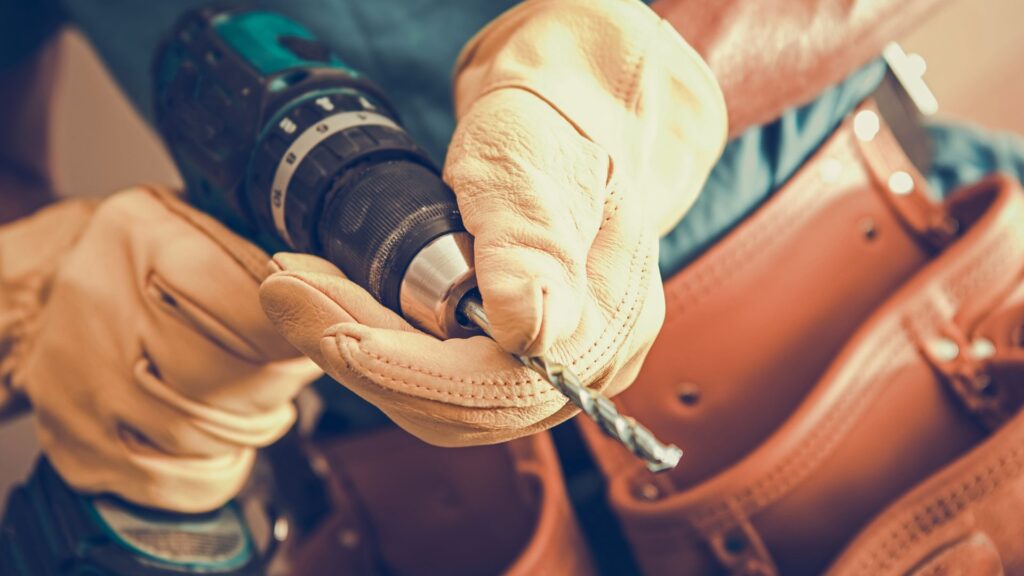
Hand tools and tool sets
- Claw hammer: A claw hammer is used to drive nails into wood and to remove nails or pry boards apart. It’s an essential tool for DIY projects that involve framing, building, or demolition. Aim for a hammer with a comfortable grip and balanced weight.
- Screwdriver set: The classic household tools. A screwdriver set includes various types and sizes of screwdrivers. It’s an essential tool for DIY projects that involve assembly, repair, or installation. Buy a screwdriver set with magnetic tips and comfortable handles.
- Pliers set: A pliers set includes various types of pliers, such as needle-nose and slip-joint, in different sizes. It’s used to grip, bend, cut, or twist wires, pipes, or other materials. It’s an essential tool for DIY projects that involve electrical, plumbing, or mechanical work.
- Utility knife: To cut various materials such as paper, cardboard, drywall, or carpet.Good projects that involve trimming, scoring, or slicing. An alternative to a utility knife is a pair of scissors or a rotary cutter, but they are less versatile.
- Chisel set: Such as bevel-edge and mortise, in different sizes. It’s used to remove or shape wood or other materials.
- Handsaw: To cut wood, plastic, or metal by hand.
- Caulking gun: To apply caulking or sealant to fill gaps or cracks around windows, doors, or pipes. For projects that involve weatherizing or waterproofing.
- Pry bar: Or crowbar is used to remove nails or screws, to pry open doors or windows, or to lift heavy objects.
- Mallet: A mallet is used to strike or tap a chisel, a hammer, or a wooden joint without damaging the surface.
- Rasps and files: Rasp sets usually contain multiple files with various coarseness.
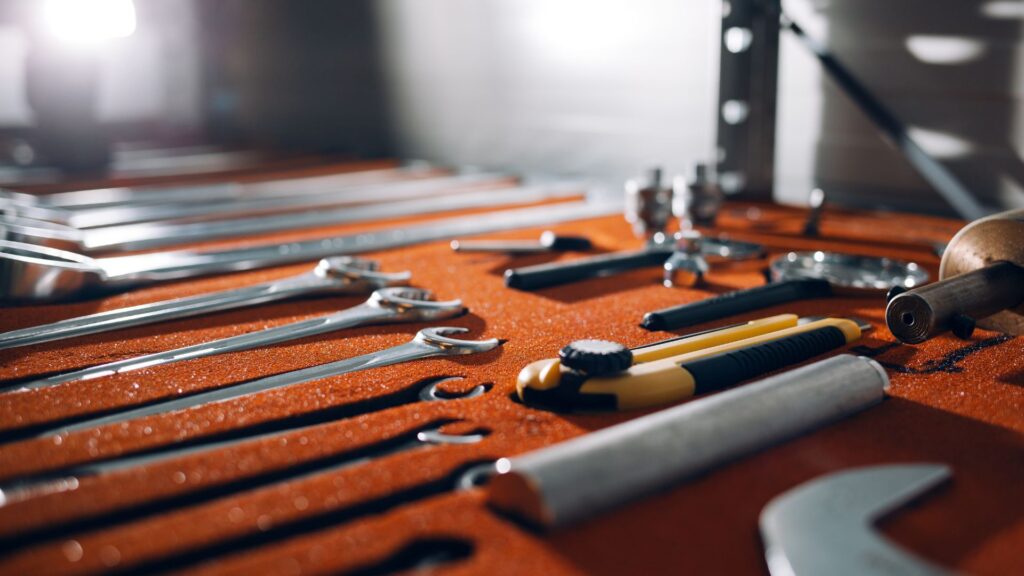
Measuring & leveling tools
- Tape measure: A tape measure is one of the standard tools for any renovation project. It’s used to take accurate measurements of length, width, and height, which are crucial for cutting materials, planning layouts, and determining square footage.
- Spirit level: A spirit level, also known as a bubble level or a carpenter’s level, is used to determine whether a surface or object is horizontal (level) or vertical (plumb). It’s essential for installing shelves, hanging pictures, or building structures. Alternatively, you can use laser level which is more advanced and precise. Some laser levels also have additional features, such as pulse mode or tripod compatibility.
- Angle finder: An angle finder, also known as a protractor or a bevel gauge, is used to measure angles or slopes between two surfaces or objects. Angle finders can be digital, magnetic, or adjustable.
- Measuring wheel: A measuring wheel, also known as a surveyor’s wheel or a distance measurer, is used to measure long distances, such as room dimensions, outdoor areas, or fencing lines.
- Vernier caliper: A vernier caliper, also known as a caliper gauge, is a precise and versatile measuring tool that can measure inner and outer diameters, depths, and thicknesses of small objects with high accuracy and resolution.
- Chalk line: A chalk line, also known as a snap line, is a tool that creates straight and visible lines on surfaces by using a string coated with chalk powder and a retractable reel or a plumb bob.
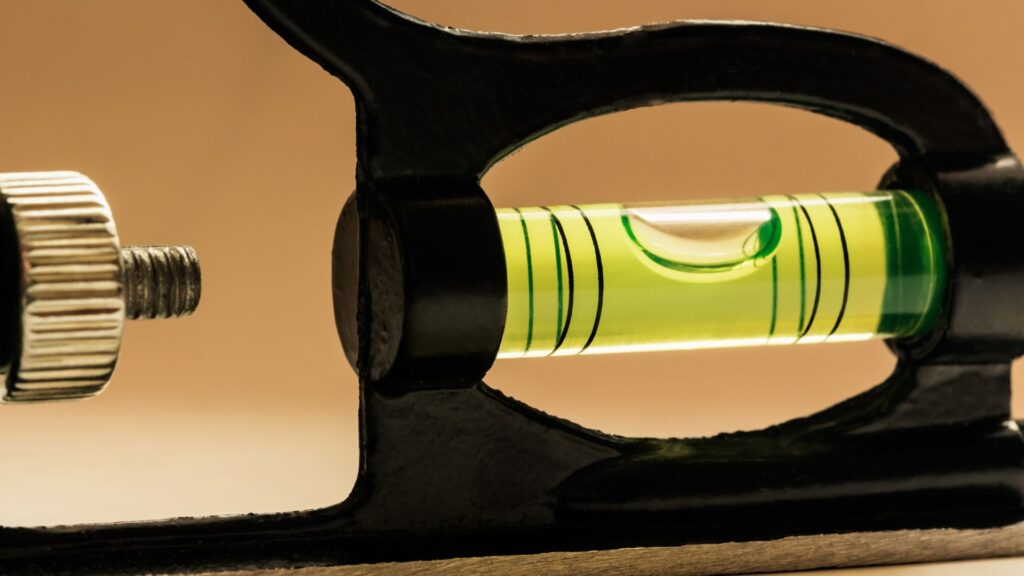
Safety gear
- Safety glasses: Safety glasses protect your eyes from flying debris, dust, chemicals, or sharp objects that can cause eye injuries.
- Dust mask: A dust mask, also known as a respirator or a face mask, filters out airborne particles, such as dust, mold, or pollen, that can cause respiratory problems or allergic reactions. It’s essential for DIY projects that generate dust or fine particles, such as sanding, sawing, or insulation. Alternatives to dust masks include powered air-purifying respirators (PAPRs) or supplied-air respirators (SARs), depending on the level of filtration and comfort required.
- Hearing protection: Hearing protection, such as earplugs or earmuffs, reduces the noise level and prevents hearing loss or damage caused by loud tools or equipment, such as saws, drills, or jackhammers.
- Work gloves: Work gloves protect your hands from cuts, bruises, burns, or abrasions caused by tools, materials, or sharp edges.
- Hard hat: A hard hat protects your head from falling objects, bumps, or electrical hazards on a construction site.
- Safety shoes: Safety shoes, also known as work boots or steel-toe boots, protect your feet from impact, compression, puncture, or electrical hazards on a construction site. They are essential for DIY projects that involve heavy lifting, moving, or working with heavy equipment, such as concrete, steel, or machinery.
- Fall protection: Fall protection, such as safety harnesses or lanyards, prevents falls from heights and protects workers from injuries or fatalities.
- First aid kit: A first aid kit contains basic medical supplies, such as bandages, gauze, antiseptic, or pain relievers, that can be used to treat minor injuries or emergencies on a construction site.
- Fire extinguisher: A fire extinguisher is a device that can be used to put out small fires caused by electrical, chemical, or flammable materials
- Knee pads: Knee pads protect your knees from impact, abrasion, or pressure caused by kneeling, crawling, or working on hard surfaces.
- Safety vest: A safety vest makes you more visible to others and increases your safety on a construction site or a road.
When selecting safety gear, it’s important to ensure that it fits properly and is comfortable to wear. The right fit will help reduce the risk of injury or fatigue while using tools or handling materials.
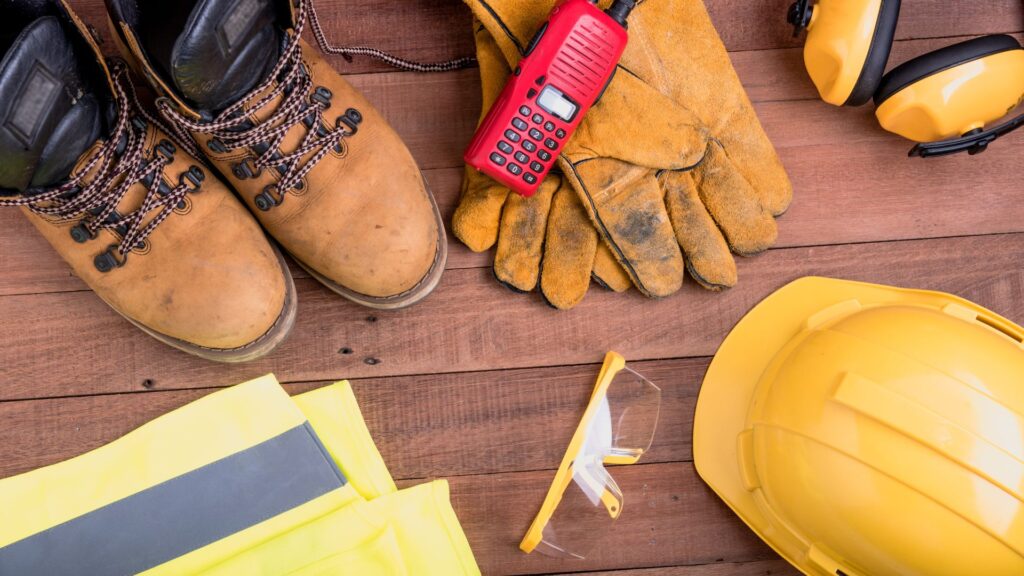
Painting gear and finishing supplies
- Paint brushes: There is no painting without paint brushes. Let’s leave it like that.
- Paint rollers: You cannot cover large areas with a paint brush. That’s where the rollers come in handy.
- Paint trays: To hold paint and load rollers or brushes with paint.
- Drop cloths: Make your life easy and protect your furniture. Drop cloths will save you lots of time.
- Putty knife: A putty knife is used to spread or scrape putty, spackle, or paint. It’s used in projects that involve filling gaps, cracks, or holes.
- Painter’s tape: To mask off areas that should not be painted, such as edges, corners, or trim.
- Paint sprayers: Usually good for large industrial spaces.
- Paint thinner: Paint thinner is essential for cleaning up spills or splatters of oil-based paints, stains, or varnishes.
Consider the type of surface and its size when selecting painting and finishing supplies.
Plumbing tools and supplies
- Pipe wrench: A pipe wrench is a heavy-duty wrench that is used to grip and turn pipes. It has serrated teeth that grip the pipe and provide leverage.
- Plumber’s tape: Plumber’s tape, also known as Teflon tape, is a thin white tape used to seal threaded pipe connections. It helps prevent leaks and provides a tight seal.
- Pipe cutter: A pipe cutter is a tool used to cut pipes to a desired length. It has a sharp cutting wheel that is rotated around the pipe to make a clean cut.
- Basin wrench: A basin wrench is a tool used to tighten or loosen nuts and bolts in hard-to-reach places, such as under sinks.
- Pipe threader: A pipe threader is a tool used to create threaded ends on pipes for easy installation and connection.
- Plumber’s snake: A plumber’s snake, also known as a drain auger, is a long flexible tool used to clear clogs in drains and pipes.
- Pipe sealant: Pipe sealant, also known as pipe dope, is a paste-like substance used to seal pipe threads and prevent leaks.
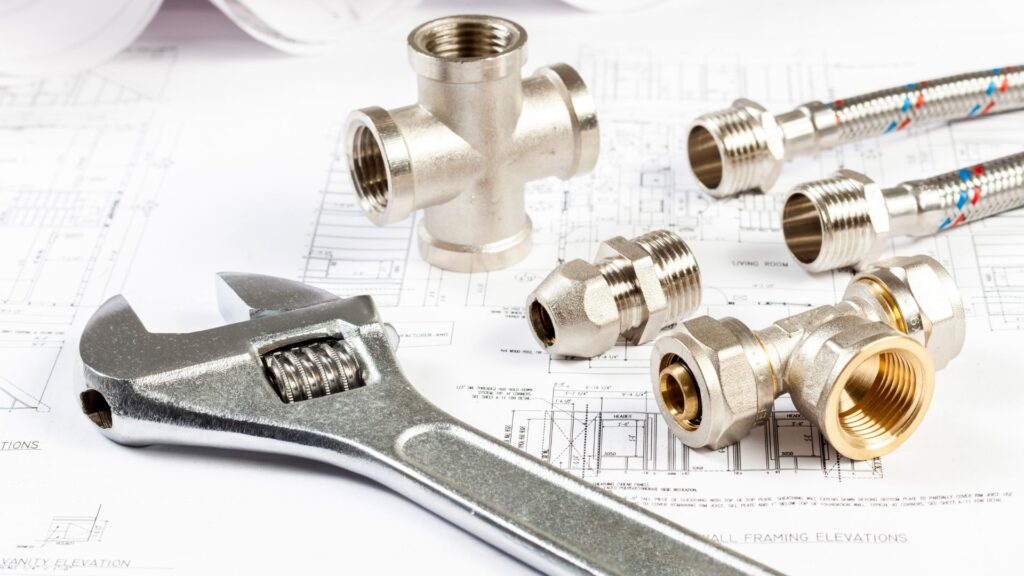
Electrical tools and supplies
PRO TIP: Keep in mind that electricity is dangerous. Electrical shock, fire hazard or code compliance are some of the issues that can arise if proper precautions are not taken. It is important to make sure that any electrical work is done by a qualified electrician, and that safety codes and regulations are followed.
If you still decide to DIY your electrical installations, these are the tools that you’ll need.
- Wire strippers: To remove the insulation from electrical wires.
- Multimeter: To measure voltage, current, and resistance in electrical circuits. This tool is essential for troubleshooting electrical problems.
- Circuit tester: A circuit tester is used to check if electrical circuits are live or dead. It is essential for ensuring safety when working on electrical circuits.
- Electrical tape: To insulate, protect and mark electrical wires.
- Wire connectors or wire nuts: To connect electrical wires together.
Flooring and tiling tools
- Tile Cutter: To cut ceramic, porcelain, or other types of tiles to desired shapes.
- Tile Saw: A tile saw is an electric saw specifically designed to cut tiles.
- Tile Nippers: To cut tiles in small sections, such as when making a curved cut.
- Grout Float: A tool used to apply grout to the gaps between tiles.
- Notched Trowel: A notched trowel is used to spread adhesive evenly on the floor before laying tiles.
- Rubber Mallet: A rubber mallet is used to gently tap tiles into place without damaging them. It is especially useful when laying large tiles.
- Tile Spacers: Tile spacers are small plastic or rubber pieces that are placed between tiles to create a consistent gap.
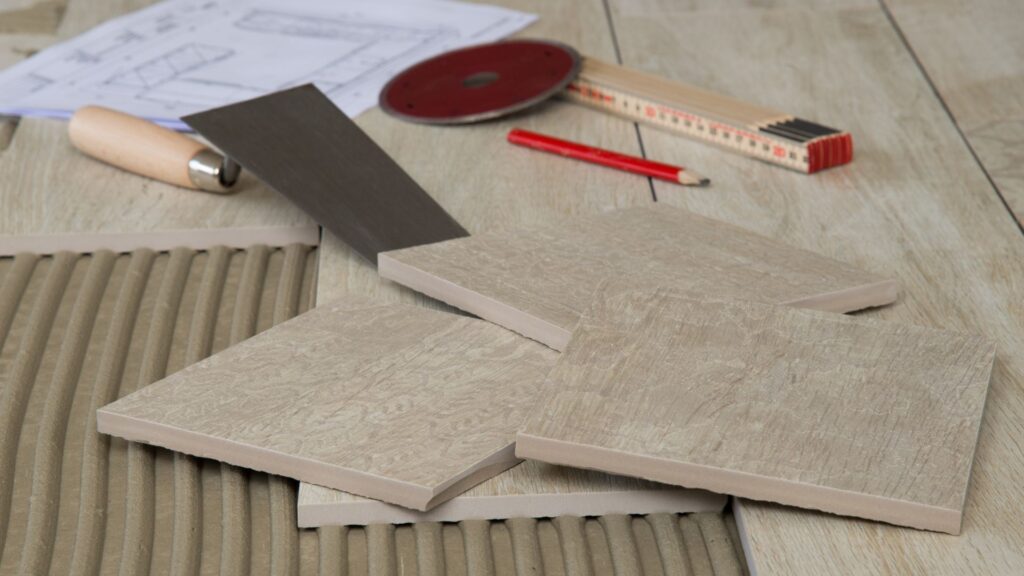
Wall and drywall repair tools
- Drywall saw: This tool is used for cutting drywall to size or making holes for outlets, switches, and other fixtures.
- Mud pan: Used for holding joint compound while you work on repairing and patching walls.
- Drywall tape: This tape is used to reinforce the seams between drywall panels.
- Stud finder: This tool is used to locate the studs behind drywall, which is important when hanging heavy objects on the wall.
- Corner trowel: This tool is used to apply joint compound to corners and edges.
- Corner bead: A corner bead is a metal or plastic strip that is used to reinforce the corners of drywall.
Conclusion
In conclusion, DIY home renovation projects can be a fulfilling and cost-effective way to improve your living space. However, it’s important to have the right tools for the job.
Always take the time to research the tools you need and invest in quality equipment to ensure your project is a success. Remember to prioritize safety, follow manufacturer instructions, and don’t hesitate to seek professional help if you are unsure about a particular aspect of the project. With the right tools and approach, your DIY home renovation project can be a rewarding experience.
Contact us today to schedule a consultation and learn more about how we can help you improve the comfort and value of your home.








